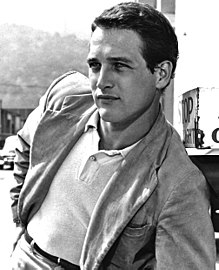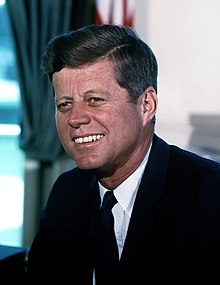Ivy League (clothes)

Ivy League is a style of men's dress, popular during the late 1950s in the Northeastern United States, and said to have originated on college campuses, particularly those of the Ivy League. It was the predecessor to the preppy style of dress.[1]
Origins
Main article: Subcultures of the 1950s

During the mid to late 1950s, many young college guys adopted the Ivy League look due to its association with the upper classes at leisure.[2] The clothing stores J. Press and Brooks Brothers represented perhaps the quintessential Ivy League dress manner, the former with two of its four locations found at Harvard and Yale universities (the Princeton branch closed in 1942). The Ivy League style was epitomized by the sack suit, which is defined as being a 3-to-2 (3 buttons with the top button "rolled" back to reveal only two usable buttons) blazer without darts and a single "hooked" vent. The pants were typically cuffed and without pleats. It was also characterized by the use of natural fabrics, shirts with button-down collars, and penny loafers. In suits, the Ivy League style was promoted by clothier Brooks Brothers and included natural shoulder single-breasted suit jackets. In 1957 and 1958, about 70% of all suits sold were in the "Ivy League" style.[3][4][5]
Typical hairstyles included the crew cut, Harvard clip, and regular haircut,[6] and common clothing accessories included cardigan sweaters, sweater vests, Nantucket reds, khaki chino pants, knitted ties, white Oxford shirts,[7] Tootal or Brooks Brothers ties, Ascot neckties, tartan, grey tweed cloth or flannel sportcoats,[8] and seersucker blazers in the South.[9]
Mainstream popularity and decline

From the late 1950s until the mid 1960s, Ivy League clothing was considered desirable mainstream apparel for middle class adults in the US. In Britain during the mid and late 60s, the Mod subculture combined the latest Italian fashions with the attire worn by the heroes in contemporary American films such as Steve McQueen, James Dean or Paul Newman.[10] Particularly popular were the grey flannel, Tonic, or houndstooth suits, polo shirts, chino pants, Argyle socks, sweater vests, cardigan sweaters, basketweave loafers, Madras plaid, and narrow brimmed Irish walking hats and Trilbys.[11] The style remained fashionable in America until it was supplanted by more casual everyday clothing influenced by the hippie counterculture during the late 1960s and early 1970s.[12]
Revival
An American style known as preppy is similar to Ivy League but intended for today's mainstream culture. Preppy style tends to be more colorful, especially in spring and summer, and incorporates more casual chic attire. It was first popularized in the early 1980s as a return to Ivy League styles after a decade of more modern trends, but today, preppy differs from historic Ivy League. Preppy fashion is influenced by traditional collegiate trends, rather than reproducing them exactly, and various clothing items can be considered preppy based on how they are worn or accented. During the 1990s and 2000s Polo Ralph Lauren, Vineyard Vines, J. Crew and J. Press were large marketers of preppy clothing, modernised to accommodate new trends inspired by indie pop and urban fashion. Controversially, in a recently revised form, a version of this style is sometimes promoted and marketed as "American Trad" or simply "Trad," although there are marked differences between the two styles. Trad is considerably narrower in scope than the original Ivy League style.[13]
By the 2010s, many American preps opted to dress in a more classic, tailored style closer to the original Ivy League look.[14] Popular clothings include loafers, Sperry Top-Sider boat shoes, Aran sweaters, cardigans, Oxford shirts, Cricket pullovers, wingtips, stripy polo shirts, hats like the fedora, khaki or pastel colored Vineyard Vines, Nantucket Reds, white or bright pastel color socks worn with sneakers and Sperry Top-Sider boat shoes, colored jeans, baseball jackets, khaki cargo shorts, and tapered chinos.[15] Blazers, especially those made from seersucker, had made a comeback as informal or smart casual wear by the mid 2010s, and the traditional two button style was updated with throwback styling inspired by The Great Gatsby.[16][17]
In popular culture
During the 1950s, the wealthy and clean cut Squares, Rahs and Socs (Soc being short for social) with their Ivy League clothes were the rivals to the working class Greaser subculture.[18] The conflict between the two groups features in Grease, The Outsiders,[19] Indiana Jones and the Crystal Skull, and Cry-Baby.[20]
The style was parodied in Clark Gesner's musical The Ivy League Look.
See also
Notes
- ^ Fashion design
- ^ Gentlemans Gazette
- ^ "ACCENT ON YOUTH IN WASH 'N' WEAR; Survey Expects Ivy League Style to Lift '58 Sales in Summer Suits Decline Seen for Wool". The New York Times. New York. 1957-08-14. p. 34. ISSN 0362-4331. Retrieved 2013-05-03.
The so-called Ivy League style in summer-weight wash-and-wear fabrics will be much more important in the boy's and young men's suit market next spring.... The three-button Ivy League suite style is expected to account for 66% of boys suits compared with 44% in the 1957. For students, the dominance of this popular model will rise from 69% to 75%, according to the survey.
- ^ JoAnne Olian (5 September 2002). Everyday fashions of the fifties as pictured in Sears catalogs. Dover Publications. ISBN 978-0-486-42219-0.
The Ivy-league look was the hallmark of sportswear throughout the latter years of the decade. Every skirt, pair of shorts or slacks boasted a cloth tab and back buckle, while button-down collars, penny loafers and Bermuda shorts were favored by both sexes. The early fifties square-shouldered, double-breasted men's suit with draped trousers bowed to the Brooks Brothers "natural shoulder" single-breasted 'Ivy League' style worn off campus as well as on.
- ^ Sumathi, G. J (2002). Elements of fashion and apparel design. New Delhi: New Age International. p. 25. ISBN 9788122413717.
Ivy League: A popular look for men in the fifties that originated on such campuses as Harvard, Priceton [sic] and Yale; a forerunner to the preppie look; a style characterized by button down collar shirts and pants with a small buckle in the back.
- ^ Boys Life 1959
- ^ Life Magazine 1959
- ^ Life Magazine 1954
- ^ Removing the Ivy League stigma
- ^ Newman and McQueen
- ^ Claudio De Rossi
- ^ Gentlemans Gazette
- ^ Pompeo, Joe (2009-09-08). "Trad Men". The New York Observer. New York, NY. Retrieved 2013-05-03.
- ^ Pompeo, Joe. "American Trad". Observer.com. Retrieved 2012-01-21.
- ^ "Ivy League look". Theivyleaguelook.blogspot.com. Retrieved 2012-01-21.
- ^ American fashion staples
- ^ 2013 blazers
- ^ Cool cars high art
- ^ Fantastic racism
- ^ Cry Baby
